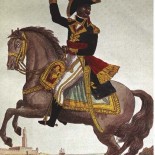SORAC 98: Presentation of Martin Bernal, Keynote Speaker
|
Martin Bernal |
Professor Martin Bernal, Keynote Speaker at SORAC 98
This page, courtesy of SORAC, introduces Professor Martin to our SORAC 98 audiences. For those who have not heard of Martin Bernal, note that he became one of the world’s most acclaimed scholars following his publication of Black Athena in 1987 (Rutgers University Press, New Jersey, New Brunswick; since then, a second volume has been published, a third volume is expected). The impact of this book on our understanding of history as it relates not only to the Africa of the Egyptians, but also to the construction of the west’s self-image has been seminal. For instance, according to Martin Bernal, ancient Greek literature and accounts acknowledge contacts with Africa and testify to Egyptian settlements in ancient Greece centuries before Greek civilization reached its peak around the 5th century BC. However, the 18th- and 19th-century classicizing establishment undertook to disprove such influences in an attempt to wipe western history clean of any elements that were likely to suggest that western civilization is itself a product of African and eastern civilizations. The success of this work has been such that the book can still be found on the shelves of national bookstores such as Barnes & Nobles more than 15 years after it was first published.
Professor Martin Bernal teaches Government at Cornell University, Ithaca, New York.
Presentation by Dr. Daniel M. Mengara, French Department. ©SORAC, Montclair State University.
“European Images of Africa: Tale of Two Names, Ethiop and N—“
This talk will be about two European images of Africans “Ethiop” and “N—-“. The shifting, blurred and overlapping semantic ranges of these words retain two distinct images. Ethiop(ian) as East African, “sable” and noble, sometimes with philosophical overtones and N—- as West African, black, fierce but sometimes with servile undertones. In this talk I shall try to outline the development of these two terms and images from the 1st millennium BCE to the 2nd millennium CE. In the first case I shall begin with Homer’s “blameless” and handsome Ethiopians, going on to Western Christians’ view of an Ethiopian Prester John and the Christian land beyond Islam that would come to the rescue of Christendom and finally the need, after the Ethiopian victory over the Italians at Adowa in 1896 and the need to “whiten” any people who could defeat Europeans. In the second case I shall argue that the ultimate origin of the river-name Niger, the Latin word “niger” “black” and N—-, is the Canaanite root NGR “nigir,” “water that is lost in the sand.” Variants of this root not only provided many names of oases but also those of their often fierce and usually black and beautiful inhabitants.
To learn more about Martin Bernal and his work, visit the Martin Bernal and Black Athena sites below.
This page will be continuously updated for more links to Bernal and Black Athena sites.




